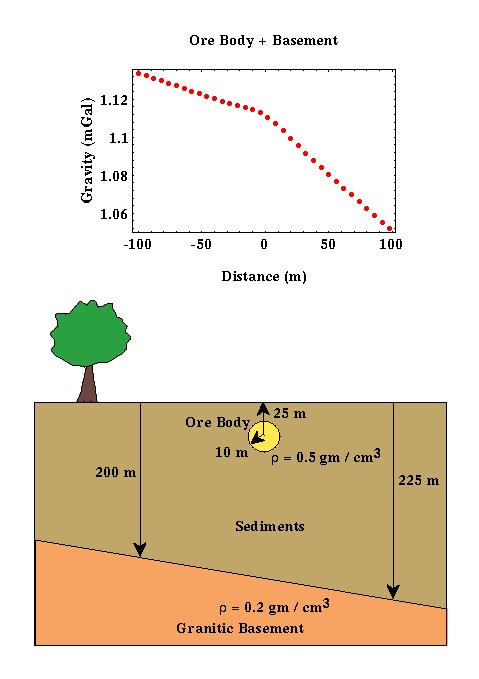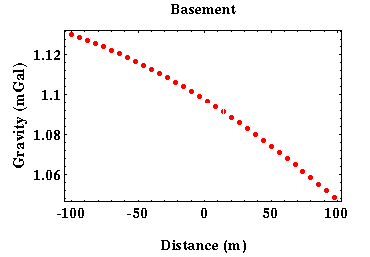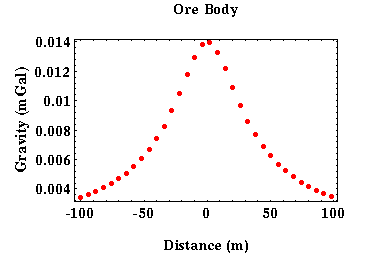Local and Regional Gravity Anomalies
In addition to the types of gravity anomalies defined on the amount of processing performed to isolate geological contributions, there are also specific gravity anomaly types defined on the nature of the geological contribution. To define the various geologic contributions that can influence our gravity observations, consider collecting gravity observations to determine the extent and location of a buried, spherical ore body. An example of the gravity anomaly expected over such a geologic structure has already been shown.
Obviously, this model of the structure of an ore body and the surrounding geology has been greatly over
simplified.
Let's consider a slightly more complicated model for the geology in this problem.
For the time being we will still assume that the ore body is spherical in shape and is buried in sedimentary
rocks having a uniform density.
In addition to the ore body, let's now assume that the sedimentary rocks in which the ore body resides are
underlain by a denser Granitic basement that dips to the right.
This geologic model and the gravity profile that would be observed over it are shown in the figure
below.

Notice that the observed gravity profile is dominated by a trend indicating decreasing gravitational acceleration from left to right. This trend is the result of the dipping basement interface. Unfortunately, we're not interested in mapping the basement interface in this problem; rather, we have designed the gravity survey to identify the location of the buried ore body. The gravitational anomaly caused by the ore body is indicated by the small hump at the center of the gravity profile.


The gravity profile produced by the basement interface only is shown to the right. Clearly, if we knew what the gravitational acceleration caused by the basement was, we could remove it from our observations and isolate the anomaly caused by the ore body. This could be done simply by subtracting the gravitational acceleration caused by the basement contact from the observed gravitational acceleration caused by the ore body and the basement interface. For this problem, we do know the contribution to the observed gravitational acceleration from basement, and this subraction yields the desired gravitational anomaly due to the ore body.
From this simple example you can see that there are two contributions to our observed gravitational acceleration. The first is caused by large-scale geologic structure that is not of interest. The gravitational acceleration produced by these large-scale features is referred to as the Regional Gravity Anomaly. The second contribution is caused by smaller-scale structure for which the survey was designed to detect. That portion of the observed gravitational acceleration associated with these structures is referred to as the Local or the Residual Gravity Anomaly.
Because the Regional Gravity Anomaly is often much larger in size than the Local Gravity Anomaly, as in the example shown above, it is imperative that we develop a means to effectively remove this effect from our gravity observations before attempting to interpret the gravity observations for local geologic structure.
Gravity
- Overviewpg 12
- -Temporal Based Variations-
- Instrument Driftpg 13
- Tidespg 14
- A Correction Strategy for Instrument Drift and Tidespg 15
- Tidal and Drift Corrections: A Field Procedurepg 16
- Tidal and Drift Corrections: Data Reductionpg 17
- -Spatial Based Variations-
- Latitude Dependent Changes in Gravitational Accelerationpg 18
- Correcting for Latitude Dependent Changespg 19
- Vari. in Gravitational Acceleration Due to Changes in Elevationpg 20
- Accounting for Elevation Vari.: The Free-Air Correctionpg 21
- Variations in Gravity Due to Excess Masspg 22
- Correcting for Excess Mass: The Bouguer Slab Correctionpg 23
- Vari. in Gravity Due to Nearby Topographypg 24
- Terrain Correctionspg 25
- Summary of Gravity Typespg 26